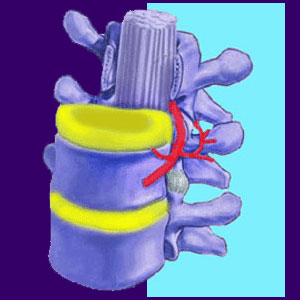
Nerve compression can be caused by structural spinal issues, as well as various soft tissue pathologies within the spinal anatomy or elsewhere in the body. A compressed nerve is said to suffer from pressure caused by some force applied to it. Although nerves are ultra-sensitive, the mere presence of a structure touching one should not elicit pain or significant effects. Instead, the offending structure will have to influence the nerves ability to carry signals in order for neuropathy to occur. In essence, contact may be incidental and innocent, but true compression will make the nerve unable to function normally.
The scope of this article will look at many of the common causes of a pinched spinal nerve and how each method is capable of generating pain within the spine.
Nerve Compression Sources
The following conditions are all typically implicated in causing structural compression of nerve roots in the vertebral column:
A herniated disc can bulge against one or more of the foraminal openings in the vertebrae. These are the egress points through which the nerves pass out of the spine. This can cause compression of the sensitive nerve tissue in rare instances. The disc material is pushing from one direction, trapping the nerve against the hard surface of the vertebrae. This variety of nerve impingement within the neuroforaminal space is called foraminal stenosis. It is also possible for the disc to bulge directly into the spinal canal, compressing many spinal nerves before they even leave the central canal. This type of compressed nerve scenario is referred to as central spinal stenosis.
There is some degree of controversy about the validity of ongoing compressive neuropathy issues theorized to be sourced by bulging or ruptured discs. Remember, continuous pressure must be exerted against the nerve in order for symptoms to occur and most disc pathologies will not be able to generate this force over an extended time frame. Of course, this is not an absolute rule.
Arthritis in the spine can cause bone spurs, which are an occasional cause of pinched nerves. Aging causes changes in our vertebrae which can lead to bone spur formation in and around the intervertebral foramen. These are the openings that spinal nerves use to leave the spine. Sometimes bone spurs can trap and compress a spinal nerve, causing symptoms. This type of pinched nerve can be a chronic problem or might resolve itself completely without any treatment at all. This condition is also commonly misdiagnosed as the actual cause of pain, since bone spur formation is a normal part of the aging process for most patients.
Spondylolisthesis can also cause pinched nerve symptoms. Sometimes the shifted vertebra can move so far forward that it will actually push against a spinal nerve root. In this case, the pinched nerve is a side effect of the spondylolisthesis and not a condition unto itself. Treatment must focus on resolving the vertebral shifting in order to be effective.
Piriformis syndrome is not compression of a nerve in the spine. It is the pinching of the sciatic nerve as that nerve passes under the piriformis muscle in the buttocks. This is a rare example of a true compressive neuralgia condition outside the spine which is caused exclusively by a soft tissue process.
Thoracic outlet syndrome is yet another example of a muscular induced compressive pathology which can affect nerves or vascular tissues in the upper back region.
Contributing Factors to Compressed Nerves
Degenerative disc disease may lead to spinal nerve compression as discs dehydrate, shrink and lose their protective mechanisms. This loss of height can cause the disc to bulge towards the spinal canal, impinging on a spinal nerve. Reduction in the size of the intervertebral spaces will also bring vertebral bones closer to one another, increasing interaction and escalating the arthritic processes.
Muscle strains and sprains might also cause a muscle to spasm and compress a nerve against a bone. Severe muscle injuries can tighten the muscle sufficiently to cause compressed nerve symptoms in any area of the back.
Lordosis can contribute to pinched nerve symptoms when an abnormal front to back curvature places pressure on the spinal nerves. This can occur from both hypolordotic and hyperlordotic diagnoses in very rare instances.
Kyphosis can also contribute to pinched nerve symptoms when the atypical curvature places pressure on the spinal nerves. Once again hypokyphotic and hyperkyphotic can both create these circumstances in extreme cases of spinal curvature.
Facet syndrome can cause nerve compression and pain. Bone spurs can build up around the spinal facet joints, causing a variety of potential neurological problems.





